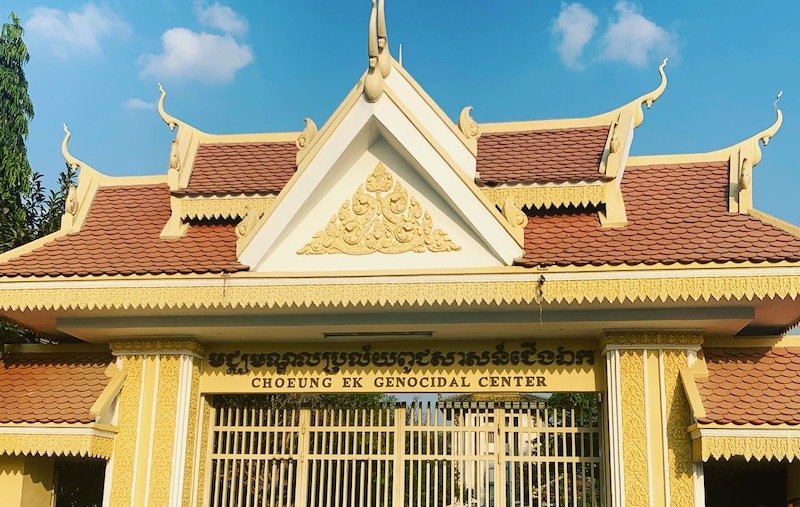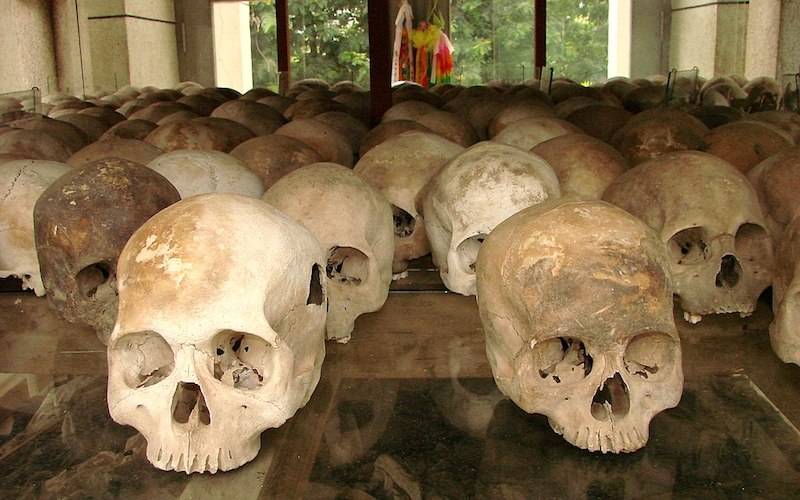The first out of the ordinary thing I did this Christmas was fly on Christmas day to Cambodia.The second was to plunge straight into dark Cambodian history on the Phnom Penh Killing fields tour. Here’s a run down of what this tour is really like. Is it worth visiting the Phnom Penh killing fields? How harrowing is the experience? Is it something you really need to visit to understand Cambodian history and culture today? Today I’m answering travellers questions on the Phnom Penh Killing fields tour.
Should you really go on the Phnom Penh Killing fields tour?
As one of the world’s most infamous dark tourism destinations, I can totally understand why someone would not want to do the Phnom Penh killing fields tour. Delving into the horrific past of the Khmer Rouge and seeing evidence of mass graves and genocide is clearly not going to be an upbeat start to any holiday.
However, mass murder under the Pol Pot regime is something that happened within most Cambodian people’s lifetime, and for the younger generation it will have likely impacted on their parents.
For me, dark tourism isn’t about having gruesome obsessions or wanting to delve into the dark and depressing. It’s simply about having an understanding of the history and culture. Almost everyone I meet will have either been directly or indirectly affected by the Pol Pot regime and I feel that I have a duty to make the effort to understand this.
A visit to the killing fields is essential to understanding Cambodia’s past. It is as essential as a visit to the Kigali genocide museum on any trip to Rwanda.
How to book a Phnom Penh Killing fields tour Online
Most hotels and guest houses winks offer a Phnom Penh Killing fields tour and they are easy to book once you arrive in Cambodia. I paid just $30 for the tour from Number 9 hotel and booked it the morning for an afternoon trip that same day. The tour only requires a half day and so you can fill the other half of the day with a Royal Palace tour or a trip to Wat Phnom. However, it is a rather heavy going day and I opted to only do this tour to preserve energy and allow time to reflect on what I saw.
If you would like to book your Phnom Penh Killing fields tour online, I’d recommend booking with GetYourGuide (specifically tours below) or booking the Viator Half day Tuol Sleng and Cheung Ek Killing Field.
How to dress for the Phnom Penh Killing fields Tour
Remember to be respectful when visiting these sites – they are a place of memorial. You will need to dress conservatively with legs and arms covered – no shorts or vest tops are allowed. Jeans or long walking trousers and a T shirt that covers the shoulders is recommended. Be silent/quiet when visiting these memorial sites and do not visit under the influence of alcohol. No smoking or eating is allowed on the grounds of S21 or the Killing Fields.
An Introduction to the History of the Pol Pot Regime
Pol Pot was in power in Cambodia between 1976 and 1979. His vision, influenced by Maosim of socialist China, was to turn Cambodia into an agrarian socialist republic with a focus on rural production. Anyone challenging this ideology was seen as challenging the state – teachers, doctors and lawyers were forced to work the land, or held as political prisoners. Pol Pots radical communism of the Khmer Rouge (his political party) resulted in the deaths approximately 1.5 to 2 million people – around a quarter of the countries population at the time. The deaths were a result of being tortured, worked to death, starvation, disease and murder. Agrarian tools were favourable weapons as bullets were expensive.
S-21 Prison (Tuol Sleng Genocide Museum)
The first stop on any Phnom Penh killing fields tour is likely to be the S-21 prison – a former secondary school that was converted into a prison and used by the regime for torture and interrogation. The prisoners included anyone who posed a threat to the regime, so as people accused of being traitors to the government such as doctors, teachers, lawyers and intellectuals.
Admission is $5 for non-Cambodian citizens (free for Cambodians) and you can hire a guide for an extra donation. An audio tour is available, but it’s well worth having a guide for the personal insights and stories about life under the Khmer Rouge. The suggested donation for a guide is $3.
Our guide – Somaly – was just 13 years old under the Khmer Rouge and she clearly remembers being forced out of the capital Phnom penh and working the land for 12 hours solid a day with little more food than a small grain of rice. Tears came to her eyes when she described how her father and brother were murdered by the Khmer Rouge. Somaly found it difficult to return to Phnom Penh in the 1980s to discover nothing left of their family home. She now lives with her mother in Phnom Penh and runs tours of the museum.
Approximately 17,000-20,000 prisoners went through S21 prison between the years 1976-1979. Most died due to the conditions, torture or were sent on to the killing fields. The site of s21 has now been turned into the Tuol Sleng Genocide Museum.
There are 4 blocks to visit in Tuol Sleng Genocide Museum. Each block shows something different about the horrific conditions at the prison…
- Torture/interrogation cells
- Photograph gallery – the interrogators and prisoners in a black and white gallery
- A preserved block as it was in the Khmer Rouge (possibly the most harrowing as individual cells of solitary confinement still exist here)
- Display of instruments of torture and art by artist and s21 survivor Buo Meng.
The most difficult block to visit is the block left intact since Pol Pot’s regime – the barbed wire is still evident which was meant to prevent suicides from jumping out of windows and off balconies. The solitary confinement cells with shackles and a small box for excrement are pretty horrific.
Only 11 people survived s21- I was lucky enough to meet two of them – Chum May (one of 7 adult survivors who was saved by his ability to mend machines) and Norng Chan Phaln who was a child survivor. Take an extra $10 with you if you would like to support them by purchasing one of their books – it helps to support them and also raise awareness about genocide.
Kiling Fields – Choeung Ek Genocidal Centre
The second part of the tour will involve a visit to the Choeung Ek Genocidal Centre built on one of the largest killing fields of Cambodia. There are no tour guides at Choeung Ek, but an audio guide is available for $3. The audio guide is harrowingly descriptive but a good way to understand what truly went on here.

Many of the previous buildings such as the executioners office and chemical substance storage room were destroyed by the Khmer Rouge and signs exist in their place to explain what went on here.
When walking through the killing fields, be sure to stick to the paths and avoid treading on any fabric (clothing of victims), teeth or bones that may have worked its way up to the surface. The mass graves are sectioned off – avoid walking on the mass graves.
Be prepared to see collections of clothing and bones from the victims of the killing fields. It’s raw and shocking, but necessary for understanding the recent history of Cambodia.
The most gruesome aspect of the killing fields is probably the ‘Killing Tree’ which was used to beat children and smash their heads. Truly a sick and inconceivable action – it was realised when the tree was discovered with bone fragments and brain tissue what had actually gone on here.
Finish the journey around the killing fields of Cambodia at the memorial stupa. Built in 1998, the stupa offers a place for reflection and memorial.
It houses over 8000 human skulls behind the glass of the inside of the stupa. It’s a truly depressing day out and a reminder of the atrocities of mankind, but Cambodians encourage tourists to visit these sites to understand the past and pay respect to the lives lost.

Further Reading on Cambodia Travel
Don’t miss my full guide to backpacking Cambodia. There are also further recommendations for Cambodia tours, Phnom Penh Tours and Siem Reap Tours.
Follow this link if you would like help planning the perfect Cambodia itinerary.
